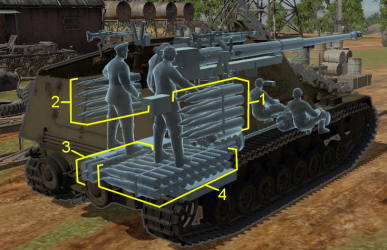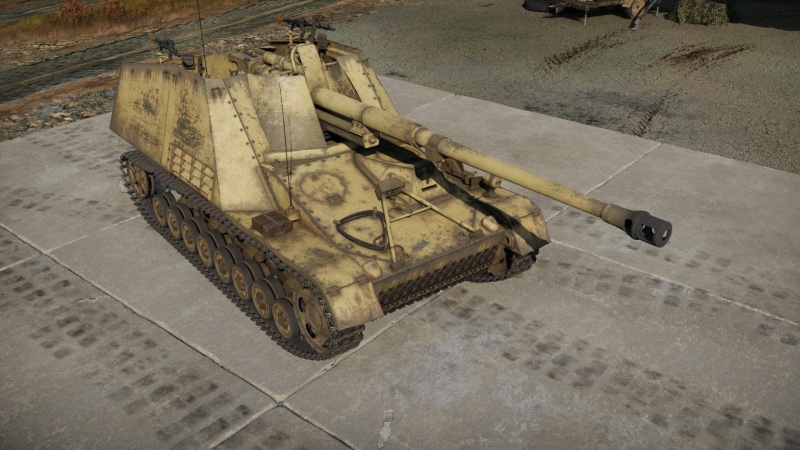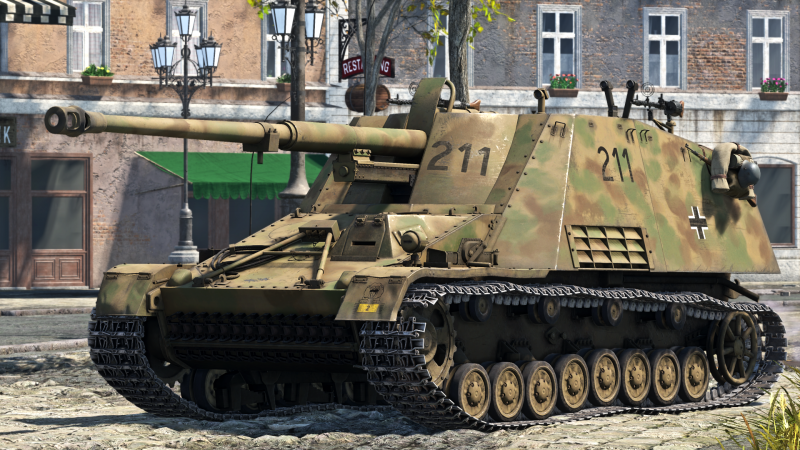Nashorn
Contents
Description
The 8,8 Pak 43/1 Sf."Nashorn" ("Rhinoceros") is a rank German tank destroyer with a battle rating of (AB), (RB), and (SB). It was introduced in Update 1.57 "Battle March". It was developed as an interim solution to deal with Soviet heavy tanks on the Eastern front who were immune to the guns of Marders. It consists of an 88 mm anti-tank gun PaK 43 mounted on a Panzer IV chassis. It is also known as the "Hornet" ("Hornisse" in German).
General info
Survivability and armour
Armour type:
- Rolled homogeneous armour (hull, gun shield, superstructure)
- Structural steel (gun breech, mudguards)
| Armour | Front (Slope angle) | Sides | Rear | Roof |
|---|---|---|---|---|
| Hull | 15 mm (72°) Front glacis 30 mm (27°) Driver port - front 30 mm (21°) Lower glacis 20 mm (21°) Add-on tracks over lower glacis |
20 mm 10 mm (33°) Driver port - side |
20 mm (10°) 15 mm (9°) Add-on wheels |
15 mm (18°) Front glacis from above |
| Superstructure | 15 mm (28°) Conical gun shield 10 mm (35°) Outer panels 10 mm (41°) Inner panels connecting with the gun shield |
10 mm (15°) | 10 mm (13°) | N/A |
Notes:
- Suspension wheels and torsion bars are 15 mm thick while tracks are 20 mm thick.
- The bottom of the hull is 15 mm thick and mudguards are 4 mm thick.
The Nashorn's armour is paper-thin; it will not protect the crew or internal modules even from heavy-calibre machine gun fire. And, the vehicle can be knocked out with overpressure from high-calibre HE rounds. The Nashorn also lacks roof protection, making it a very desirable target for enemy fighters and attackers. Stay behind cover to avoid strafing runs or rocket attacks. One interesting (and somewhat comical) note on the Nashorn's armour is that being so thin, high-penetration shells may pass through it without detonating at all.
Mobility
| Game Mode | Max Speed (km/h) | Weight (tons) | Engine power (horsepower) | Power-to-weight ratio (hp/ton) | |||
|---|---|---|---|---|---|---|---|
| Forward | Reverse | Stock | Upgraded | Stock | Upgraded | ||
| Arcade | Expression error: Unexpected * operator. | 426 | Expression error: Unexpected round operator. | __.__ | |||
| Realistic | 265 | Expression error: Unexpected round operator. | __.__ | ||||
Being based on the chassis of the Panzer IV, the Nashorn benefits from the same all-round mobility: the tank accelerates and brakes quickly and is able to reach its max speed of 43 km/h in a dozen of seconds. While there is no neutral steering, turning on the spot is still easily done as it is a light vehicle. The reverse speed is average and won't let you back quickly from a dangerous situation. If you need to quickly turn your hull on the spot towards flanking enemies, privilege the reverse gear as it has more torque. The offroad mobility is good: the Nashorn can reach 12 km/h when climbing uphill from idling and 15 km/h when fording. The "Ostketten" wide tracks for snowy terrain also offer an improved offroad handling. Only big obstacles will hinder your mobility (large trees, concrete blocks, parked vehicles). In short, the Nashorn's mobility is good enough for the role it fulfills.
Modifications and economy
Armaments
Main armament
| 88 mm PaK43 | Turret rotation speed (°/s) | Reloading rate (seconds) | |||||||||||
|---|---|---|---|---|---|---|---|---|---|---|---|---|---|
| Mode | Capacity | Vertical | Horizontal | Stabilizer | Stock | Upgraded | Full | Expert | Aced | Stock | Full | Expert | Aced |
| Arcade | 40 | -5°/+20° | ±15° | N/A | 10.6 | 14.6 | 17.8 | 19.6 | 20.9 | 8.71 | 7.70 | 7.10 | 6.70 |
| Realistic | 7.1 | 8.4 | 10.2 | 11.3 | 12.0 | ||||||||
The 88 mm PaK 43 gun has great penetration characteristics at all ranges and angles with an average reload time. Due to the vehicle's design, the gun should be used to snipe enemy targets from long ranges. Most enemy tanks will be crippled or destroyed if a shot connects.
Ammunition
The available ammunition allows for engaging all types of targets:
- PzGr 39/43: APCBC; an armour-piercing shell with a high penetration power and an explosive filler that will destroy any tank that is penetrates.
- PzGr 40/43: APCR; a composite round with the best penetration but no explosive filler and will only penetrate flat vertical surfaces.
- Hl.Gr 39: HEAT; a shaped charge with average penetration but without penetration loss over distance. Only penetrates flat vertical surfaces but the post-penetration damage is very effective on open and lightly armoured vehicles. Very slow shell travelling at circa half the speed of your fastest projectiles.
- Sprgr.43: HE; useful for destroying aircraft and lightly armoured vehicles. Slow shell travelling at circa 3/4 of the speed of your fastest projectiles.
| Penetration statistics | |||||||
|---|---|---|---|---|---|---|---|
| Ammunition | Type of warhead |
Penetration @ 0° Angle of Attack (mm) | |||||
| 10 m | 100 m | 500 m | 1,000 m | 1,500 m | 2,000 m | ||
| PzGr 39/43 | APCBC | 237 | 234 | 222 | 207 | 194 | 181 |
| PzGr 40/43 | APCR | 279 | 273 | 252 | 227 | 205 | 185 |
| Hl.Gr 39 | HEAT | 110 | 110 | 110 | 110 | 110 | 110 |
| Sprgr.43 | HE | 14 | 14 | 14 | 14 | 14 | 14 |
| Shell details | |||||||||
|---|---|---|---|---|---|---|---|---|---|
| Ammunition | Type of warhead |
Velocity (m/s) |
Projectile Mass (kg) |
Fuse delay (m) |
Fuse sensitivity (mm) |
Explosive Mass (TNT equivalent) (g) |
Ricochet | ||
| 0% | 50% | 100% | |||||||
| PzGr 39/43 | APCBC | 1,000 | 10.16 | 1.2 | 14 | 108.8 | 48° | 63° | 71° |
| PzGr 40/43 | APCR | 1,130 | 7.3 | N/A | N/A | N/A | 66° | 70° | 72° |
| Hl.Gr 39 | HEAT | 600 | 7.64 | 0 | 0.3 | 1,100 | 62° | 69° | 73° |
| Sprgr.43 | HE | 820 | 9.4 | 0 | 0.1 | 1,000 | 79° | 80° | 81° |
Ammo racks

| Full ammo |
1st rack empty |
2nd rack empty |
3rd rack empty |
4th rack empty |
Visual discrepancy |
|---|---|---|---|---|---|
| 40 | 33 (+7) | 25 (+15) | 21 (+19) | 1 (+39) | No |
Notes:
- Racks disappear after you've fired all shells in the rack.
- To go into battle with the flanks empty of ammo, pack 25 (+15) shells (racks 1 and 2 empty).
Machine guns
| 7.92 mm MG34 | ||||
|---|---|---|---|---|
| Mount | Capacity (Belt) | Fire rate | Vertical | Horizontal |
| Pintle - left side | 2500 (150) | 900 | -5°/+15° | -125°/-5° |
| Pintle - right side | 2500 (150) | 900 | -5°/+15° | +5°/+120° |
The Nashorn has two MG34 (7.92 mm) machine guns covering the vehicle's flanks. Since they are secondary weapons, there are no ammunition belt options. Furthermore, they have various blind spots (e.g. the rear and the front of the tank and the area above the vehicle). The machine guns have an elevation of only +15°, rendering them useless against diving fighters or bombers.
Usage in battles
The Nashorn is a classic German tank destroyer, and its greatest selling point is its armament. The 88 mm PaK 43 gun has great penetration an great destructive power. It can destroy most opponents in one shot, and is an all-around great gun. Reload times are average. The best way to use this gun is in a sniping position, firing from behind a ridgeline or from behind cover. However, the Nashorn has bad gun depression, which can make ridgeline firing sometimes dangerous.
At close ranges, the Nashorn loses much of its effectiveness since it lacks a traversable turret and has poor survivability.
Speaking of, this vehicle's armour is very thin. It will not protect internal components from heavy-calibre machine gun fire, and it certainly can't defend against full-calibre tank shells. Sometimes, high-penetration shells will overpenetrate and pass through the vehicle without detonating, but this should not be counted on. Most of the time, any hit that connects will do great damage to the tank. Additionally, this vehicle has a large silhouette and can be destroyed by largecalibre HE rounds. Even worse, the Nashorn is open-topped, which means that artillery is a significant threat. Enemy planes will also see the Nashorn as a highly desirable target, since strafing runs can cripple or destroy the vehicle. The Nashorn has no way of defending against this. It is equipped with machine guns, but they do not have enough elevation to fire at planes. To avoid artillery and fire from planes, stay behind cover: shrubbery and buildings work well for this.
As a sniping-based tank destroyer, the Nashorn's mobility is not its most important feature. Still, it's nice that the vehicle has good mobility all around. The tank accelerates and brakes quickly and is able to reach its max speed of 43 km/h in normal gameplay. While there is no neutral steering, turning on the spot is still easily done as it is a light vehicle. (Even so, the lack of a turret means that flankers are still very deadly. Watch out for them.) The reverse speed is average and won't let you back quickly from a dangerous situation. (This is important to note when peeking out from behind cover to take a shot.) Thanks to its good mobility, the Nashorn is able to reach sniping positions in a reasonable amount of time or to relocate mid-game if necessary. The Nashorn should be played with a squad to back it up in case of the gun or breach being destroyed or if anyone flanks it with any caliber weapon
Pros and cons
Pros:
- The powerful 88 mm PaK 43 cannon can destroy most, if not all, opponents in one shot
- The thin armour may cause some shells to overpenetrate (pass through the tank without detonating)
- Two machine guns to deal with lightly armoured targets
- Reload times are faster than those of the Tiger (Germany) tanks.
- The mobility of a Panzer IV
Cons:
- Has next to no armour and can be penetrated by .50 cal machine guns
- Crew are vulnerable to overpressure (artillery, HE, rockets) and strafing aircraft
- Ammo racks are exposed on the sides of the crew compartment
- Horrible gun depression
- Very tall silhouette
History
Design
In 1942, the German tank destroyers equipped with 75 mm guns (Marder & StuG IIIs) became ineffective following the arrival of uparmoured Soviet KV heavy tanks on the Eastern front. To quickly answer that situation, the German command mandated an interim vehicle to be proposed before the arrival of a properly designed heavy Panzerjäger. The interim solution was to rely upon the newly developed anti-tank cannons whose caliber had proven very effective even against heavily armoured targets.
Development
The firm Alkett in charge of producing Pz.III and StuG III quickly proposed the Nashorn, born of the assembly of an anti-tank gun and a turretless tank chassis. An anti-tank 88 mm PaK 43 cannon was installed on a Panzer IV chassis and a superstructure built around the rear of the vehicle to provide a protected crew compartment. The engine was then moved from the rear to the central section of the chassis: the drive train of a Panzer III was used to achieve the result. The newly created Panzerjäger provided the devastating firepower of an anti-tank gun with the good mobility of a medium tank. The protection was however lacking, as it was a stop-gap vehicle. Parallel to the Nashorn equipped with an AT gun, the firm Alkett proposed the Hummel on the same chassis but equipped with a 150 mm howitzer. The Nashorn was approved by the German command and entered production in 1943. 494 vehicles in total were built from 1943 to 1945.
Combat usage
The Nashorn first saw combat at the battle of Kursk in 1943. It served mainly on the Eastern front in heavy tank destroyer battalions ("Schwere Panzerjäger-Abteilungen") and proved deadly in the Eastern flat steppes. It was also used in Italy to a lesser extent but did not achieve the same combat performance due to the relief and lack of visibility.
Media
- Skins
- Videos
See also
- Vehicles equipped with the same chassis
External links
- [Devblog] Nashorn: the German 'Rhinoceros'
- [Wikipedia] Nashorn
- [Tanks Encyclopedia] 8.8 cm PaK 43/1 auf Fgst.Pz.Kpfw III und IV (Sf) Sd.Kfz. 164 "Nashorn"
| Germany tank destroyers | |
|---|---|
| Pz. I Derivatives | Panzerjäger I |
| Pz. II Derivatives | 15cm sIG 33 B Sfl |
| Pz. 38(t) Derivatives | Marder III · Marder III H · Jagdpanzer 38(t) |
| Pz. III Derivatives | StuG III A · StuG III F · StuG III G · StuH 42 G |
| Pz. IV Derivatives | Jagdpanzer IV · Panzer IV/70(A) · Panzer IV/70(V) · Dicker Max · Nashorn · Brummbär · VFW |
| Pz. V Derivatives | Jagdpanther G1 · Bfw. Jagdpanther G1 |
| Pz. VI Derivatives | Sturer Emil · Elefant · Ferdinand · 38 cm Sturmmörser · Jagdtiger |
| Wheeled/Half-track | 8,8 cm Flak 37 Sfl. · Sd.Kfz.251/9 · Sd.Kfz.251/10 · Sd.Kfz.251/22 · Sd.Kfz.234/3 · Sd.Kfz.234/4 · 15 cm Pz.W.42 |
| ATGM Carrier | RakJPz 2 · RakJPz 2 (HOT) · Wiesel 1A2 |
| Other | Waffenträger · M109G · JPz 4-5 · Raketenautomat · VT1-2 |






